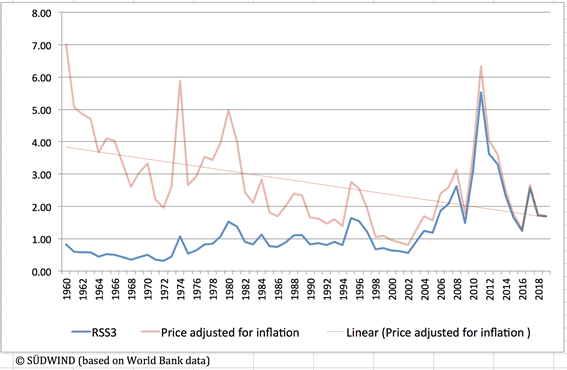SIX YEARS ON : THE PRICE REMAINS THE SCANDAL


The roots of the Fair Rubber Association (FRA) go back to 2006, but the Association itself is in its seventh year only. In marriages this is sometimes called the ‘cursed 7th year’ – but for the Fair Rubber Association it is mostly a case of coming of age:
The number of members and products keeps increasing, from a big Australian glove company to a totally reusable and recycle-able water bottle made from glass – with a Fairly Traded natural rubber seal. And after six years the staff has also expanded (see notice on the left), which was one precondition required for our most exciting new development: The FRA no longer depends on Forest Stewardship Council (FSC) criteria, with a ‘bolted on’ Fair Trade component for the Fair Trade premiums. We now have our own brand new FRA criteria (which can be downloaded here: criteria). And what is more: All our supplier partners are now being independently audited against these criteria – as you read this newsletter.
While this is cause for celebration (in our view), there is also some sadness mixed into this development: We know that audits are not only expensive (although the Fair Rubber Association pays for our criteria to be audited: How could we call ourselves a Fair Trade organization aiming to help ‘disadvantaged producers’ – and then start out by charging for an audit – without being in a position to guarantee any Fair Trade sales)? They also take time and to prepare on the partner’s side. Hence we tried very hard, to ensure that a lot of parameters which are already audited for other standards do not require re-auditing for ‘our’ audit. E.g. all the environmental standards were (with kind permission) copied from the FSC criteria set, i.e. the FRA audit will focus on the accounting for Fair Trade premiums received, both financially – and most importantly – structurally: Who took the decision on how to use the extra money? The joint bodies are required to have audit books to be able to follow the decision making trail.
And our one Fair Trade and organic certified partner requires zero additional auditing.Even so, some sadness remains that we have become so big, that we have grown out of the close circle of trusted colleagues and partners: In order to justify the trust of consumers buying products with the Fair Rubber logo, we must have these third party audits – they are in this day and age simply a ‘necessary evil’.And they must not distract from the fact that even if all criteria are fulfilled – until the supplier partners receive a Fair price for their material, ‘all’ audits can do is ‘document’ the ongoing injustice in global trading patterns.At a round table discussion on sustainable natural rubber in Bonn at the end of September, with participants from car, tyre, and other rubber users, as well as traders and Non Governmental Organization representatives, no one contested that the price for natural rubber remains woefully low, basically below the cost of production. The result: Rubber trees are abandoned, or uprooted to make space for palm oil. The last period of high prices was in 2011 – seven meagre years for rubber growers, and no improvement in sight. A trader pointed out that the current prices are lower than those paid in the 1980s.
Except, of course, for every kg of rubber traded under FRA criteria: the extra of EUR 0.50/kg DRC (Dry Rubber Content) ensures that suppliers earn more than their production costs.Those trying to find (major) social or environmental ‘faults’ with natural rubber simply blame the wrong reason. Natural rubber is a superior product environmentally (instead of fossil fuel; extremely high CO2 absorption) – and on the social side the scandal remains that the growers of such a super product cannot even afford the bus fair for the children to go to school – because the car and tyre companies (and heir customers) are not willing to pay EUR 6(!) extra for four tyres (3×4 kg natural rubber): That would be the Fair Trade premium on an average set of car wheels.
